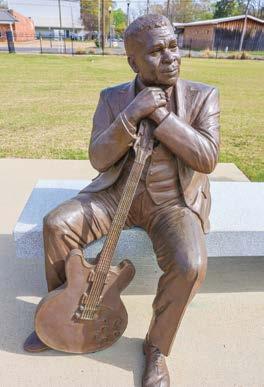





























































































































































































































This month marks the 90th anniversary of electric cooperatives in America.
On May 11, 1935, President Franklin D. Roosevelt issued an executive order to create the Rural Electrification Administration (REA). The order was part of the Emergency Relief Appropriation act passed by Congress to alleviate su ering and hunger during the depression, according to the book, “Rural Electrification in Mississippi 1934-1970” by Winnie Ellis Phillips.


The executive order led to a law by Congress — The Rural Electrification Act of 1936 — which empowered rural communities to bring electricity to their communities via loans from the REA.
The issue of a lack of electric power in rural areas was especially significant in Mississippi, where “only ninetenths of 1% of Mississippi’s farms were electrified.”
Mississippi led the nation in securing electric power for rural residents.
Alcorn County Electric Power Association in Corinth was America’s first rural electric cooperative. Monroe County Electric Power association in Amory was the nation’s first REA cooperative to energize its system in 1936.
Today, Mississippi has 25 distribution electric cooperatives and one generation and transmission electric cooperative.
The state’s electric co-ops provide electric service to more than 1.8 million Mississippians.
Mississippi State University o cially broke ground in March on the Northern Gulf Aquatic Food Research Center, a first-of-its kind facility in Mississippi dedicated to aquatic food safety, quality assessment, processing and product development.
The area is serviced by Singing River Electric.
The ceremony, hosted by the Jackson County Economic Development Foundation, or JCEDF, recognized more than five years of collaborative work with MSU on the multimillion-dollar facility. Construction of the Mississippi Agricultural and Forestry Experiment Station, or MAFES, research center is a combined investment of $3 million from the federal RESTORE Act and $865,000 from the Gulf of Mexico Energy Security Act, or GOMESA, as well as $4 million from the state to cover fixed equipment including walk-in coolers and freezers and fume hoods for the laboratory.

The first of three planned structures, the building will house a biosafety laboratory for testing pathogens and toxins and an analytical chemistry lab for measuring chemical residues in water and aquatic food products such as seafood and catfish. The lab will facilitate research on new processing methods to extend shelf life — reducing waste — and o er new value-added food products and processing techniques using locally produced aquatic foods that often leave the state for value-added processing elsewhere.
The research center will be located at the Sunplex Light Industrial Complex on Highway 57, near the Interstate 10 corridor. The facility and its strategic location are the result of dedicated teamwork between MSU and Jackson County entities, including the Jackson County board of supervisors, port authority and JCEDF, which recruited MSU to locate its coastal facility in Jackson County.
With the seafood industry contributing over $300 million annually to the state economy, the new research center will help Mississippi meet a critical need for one of its largest industries. It also will help the state’s catfish producers, who manage 29,900 freshwater pond acres, with a total production value of $214 million in 2024.
Mary Martha Henson, JCEDF deputy director, noted the facility will draw scientists from other research-intensive universities in the region to collaborate with MSU.
The center also will o er opportunities to work in close proximity to the distinctive assets and amenities the Mississippi Coast provides.





While in college, we amused ourselves without spending much money that we didn’t have by throwing Frisbees at trees, road signs, mailboxes, and other objects.
We even had friendly little competitions to see who could hit the object in the fewest throws. That was more than 40 years ago. Since then, disc golf exploded exponentially across the world.
“I started playing disc golf about six years ago,” recalls Damon Parker of Petal, former president of the 1,900-member Hattiesburg Disc Golf Association. “I just planned to play casually with some friends, and it developed into competing in tournaments.”


“To start the game, players come to a T-pad and throw discs at a basket,” Parker said. “The disc must go into the basket. Anything else counts as a stroke. Like in golf with a ball, the object is to go from the T-pad into the basket with the fewest strokes.”
To start the game, players come to a T-pad and throw discs at a basket. The disc must go into the basket. Anything else counts as a stroke. Like in golf with a ball, the object is to go from the T-pad into the basket with the fewest strokes.
Disc golf generally follows the rules of golf with a ball. The major di erence, disc golfers try to put their discs into baskets 24 inches in diameter instead of hitting a ball into a hole.
Players throw di erent types of discs. Use fairway drivers from the T-pad to get the most distance to the basket. Use mid-range discs for throws of about 200 feet or less and putters for shorter throws on the greens.
“People used to go to parks and move garbage cans around to serve as baskets if they didn’t have a real course,” Parker said. “Now, we have courses all over the state. Most Mississippi state parks have courses. Disc golf is a sport that people of all ages can play alone or with a group. In our club in Hattiesburg, we have players from 12 years old to folks in their 70s.”
“As years of weekly changing menus passed, we felt limited by the available produce. My partner Adrienne and I were on vacation in Fiji when we visited an organic farm that was a garden of Eden with almost unlimited unusual edible and medicinal plants. On the flight back, we decided to look for a property where we could create our own little food paradise. That was about 2017 when we were on the trip, and we bought the Mississippi farm in 2018,” Foundas said.
Because Foundas’s restaurant focuses on zero waste cooking and complex flavors, fermentation is a key aspect of the process.
“For example, at the end of a weekly menu, we may have extra brussels sprouts and roast corn. So, we might make brussels sprout kimchee and roast corn miso,” Foundas said.
The Tiki Food Lab and Education Center is not just about fueling the menus of the restaurant. There are food experiences open to the public at the Pearlington facility, including a farm tour, cooking classes, and chef-curated meals based on di erent topics.


“We have done classes on miso making, introduction to fermentation, wine and vinegar making, and barbecue techniques from around the world. We have also had events featuring well known neurologists discussing the synergy between the micro biome and brain function — and then prepared a meal that provides food for thought! Another event is the poetry menu, where the guests prepare an eight-line poem that turns into their eight-course menu,” he said.
The reaction from the public has been positive.
“People seem to be really interested in foods that make you healthy and boost your immune system, which is what fermented and organic foods do. Plus, an evening at the Tiki Farm is like being on vacation in the South Pacific, but just a short drive from New Orleans, Biloxi, or Picayune,” Foundas said.
Although Foundas spends most weekdays at the restaurant, his weekends are spent in Pearlington at the farm.
“I’m originally from New Orleans and have been visiting the Gulf Coast since I was a child, so I have an a nity for the area. We love the proximity to the coast, the beauty of the bayou, and the interest in business development from Hancock County.”
For more information about the farm, visit tikifoodlab.com or call 504-338-2986.






















• Rate schedule is based on your current age and is guaranteed for the life of the policy.
• Monthly rates as low as $3.49.
• Coverage is also available for your spouse and other family members.
• Benefits will NEVER be canceled or reduced for the life of the policy if premiums are paid on time. Policy Form #SRTCV/SRTCV R13 or R17, or #SRTCV90MA in MA














• Rates are based on your children’s or grandchildren’s present age and never increase for any reason.
• Monthly rates as low as $2.17.
• Benefits will NEVER be reduced or canceled if premiums are paid on time.
• Give your children a financial head start right now. Your policy builds CASH VALUE for your family’s needs. Policy Form #GWL2001 or GWLA001































Magnolia Electric Power (MEP) members gathered on March 27 in the company’s auditorium at the headquarters in Summit, where three incumbent directors were re-elected to their posts.
During the business meeting, Jerry Sisco, Carl Fuller, and Odell McKenzie were re-elected to three-year terms on the board of directors. This election was directed by board attorney, Reggie Jones.
The 2025 Annual Meeting proxies, which were returned first to White and Associates LLP, an independent Certified Public Accounting (CPA) firm, were counted and certified by the firm before being turned over to the MEP Elections and Credential Committee.
The Elections and Credential Committee, comprised of one appointed MEP member for the six districts not up for election, met on March 24 and validated the proxies for the board elections.
As part of the business meeting, Auditor Mark Biggs informed those in attendance that MEP remains in sound financial condition.
MEP General Manager Darrell Smith gave an Annual Meeting report, too. Manager of Member Services and Communications Lucy Shell gave a brief review of the Cooperative Youth Leaders program.
President Dennis Wilson and Assistant Secretary Odell McKenzie also conducted a portion of the business meeting.
Before the Annual Meeting was dismissed, winners’ names for door prizes were drawn for those in attendance.
The winners in attendance included Roger Moak, who won $500 in a credit for electricity. Those receiving a $50 credit on their electric bill are Glenn Callies, Marlin Mullins, Vernon Alford, Mack Frazier, and Dudley Boudreaux.
Prior to the meeting, winners from those who sent in proxies were drawn. The proxy winners, who have been notified by mail, include Amy E. Coon, who won $500 in a credit for electricity. Those receiving a $50 credit on their electric bill are: Kenneth L. Gordon, Donny Cupit, Paul Gatlin, Jimmy Gatlin, and Charles L. Dunaway.
MEP is an electric cooperative and holds an Annual Meeting for its members. Members participate by either returning their proxy or attending the meeting.















In a March 20, 2025, news article, the Mississippi Emergency Management Agency reported the following information. We have condensed the statewide listing to Pike and Walthall counties, which were the most a ected counties in our service territory.
The Mississippi Emergency Management Agency (MEMA), along with state and local o cials, hundreds of volunteers, faith-based organizations, and private sector partners, is actively responding to the severe weather that struck the state on March 14 and 15, resulting in the loss of seven lives and injuries to dozens more.

MEMA teams are in the process of validating damage reports as counties conduct ongoing assessments.
To date, the agency has recorded damage to 941 homes, 38 businesses, and 25 farms across the state. Of the homes a ected, 164 were destroyed, while 204 sustained major damage.
These figures are subject to change as further evaluations are conducted. MEMA has filled requests for 1,000 sandbags, 1,300 tarps, and more than 24,000 bottles of water for counties.
The National Weather Service has confirmed that 18 tornadoes touched down on March 14 and 15 in Mississippi, including one EF-4, one EF-3, seven EF-2, seven EF-1, and two EF-0 tornadoes.
The following counties have submitted o cial damage reports to the Mississippi Emergency Management Agency. Damages reported range from a ected to destroyed. These numbers can change through the assessment process.
Pike ................ 25 homes
Walthall 182 homes, 6 farms, 4 deaths











Purvis, MS - If you experience numbness or tingling in your hands, arms, legs, or feet or if you experience shooting or burning pain, this is important.
Please read this carefully

Peripheral Neuropathy is when small blood vessels in the hands, arms, feet or legs become diseased and tiny nerves that keep the cells and muscles working properly shrivel up and die.
Early-warning symptoms include tingling and numbness, mild loss of feeling in your hands, arms, legs or feet, inability to feel your feet, which increases your risk of foot-injury and falling
More Advanced Symptoms Include...
Loss of coordination & dexterity, which puts you at increased risk of accidents
Inability to feel clothing like socks and gloves
High risk of falling, which makes walking dangerous, and makes you more dependent on others
Burning sensations in your arms, legs, hands or feet that may start mild, but as nerves and muscles die, may feel like you're being burned by a blow torch.
Ignore the early warning signals long enough and you risk progressive nerve damage leading to muscle wasting, severe pain, loss of balance and a lot of staying at home wishing you didn't hurt
When every step is like walking on hot coals, sitting still may be the only thing you feel like doing But there's little joy in sitting still all day long

Now here's the scary part....
Nerve damage CAUSES cell damage Cell damage SPEEDS UP nerve degeneration
Without treatment this can become a DOWN-WARD SPIRAL that accelerates.
The damage can get worse fast Mild symptoms intensify Slight tingling, numbness or lack of feeling can turn into burning pain.
Before you know it, damage can become so bad you hurt all the time
Unless this downward spiral is stopped and nerves return to proper function - the damage to nerves and cells in the affected area can get so bad your muscles begin to die right along with the nerves and cells. And that sets the stage for weakness, loss of mobility, disability, and dependence on others.
If you have early warning signs of peripheral neuropathy, (tingling &/or numbness, loss of feeling or pain) it's CRITICAL you get proper treatment
It's critical, because with proper treatment the symptoms can often be reversed Without it, you are playing Russian Roulette with your health
Once your nerve loss reaches 85%, odds are there's nothing any doctor can do to help.
The most common method your doctor may recommend to treat neuropathy is prescription drugs

Drugs like Gabapentin, Lyrica, Cymbalta, & Neurontin are often prescribed to manage the pain But, damaged nerves and dying cells do not heal on their own
Pain pills do not restore healthy nerve function. They just mask the pain as the nerves continue to degenerate and cells and muscle continue to die.
Taking endless drugs and suffering terrible side effects that may damage your liver & kidney and create even more problems, is not a reasonable path. You deserve better. Three things must be determined to effectively treat neuropathy 1) What is the underlying cause? 2) How much nerve damage has been sustained? 3) How much treatment your condition will require?
With proper treatment, shriveled blood vessels grow back & nerves can return to proper function How much treatment you may need depends on your condition
At Purvis Chiropractic we do a complete neuropathy sensitivity exam to determine the extent of your nerve damage The exam includes a detailed sensory evaluation, extensive peripheral vascular testing, & a detailed analysis of the findings.
Dr Rob Acord, D C will be offering this complete neuropathy sensitivity exam for $47 This special offer goes away at the end of this month as we have a limited number of exam appointments available
Stop Hurting & Start Healing
Call

by Jim Beaugez
“The thrill is gone — it’s gone away for good,” sang B.B. King on his biggest hit, the 1970 crossover smash “The Thrill is Gone.”
But while he was singing from the perspective of a jilted suitor on the tune that earned his first of 15 Grammy awards, when it came to making music and performing, the blues legend, whose career spanned seven decades, never lost the spark.
“Once he picked up that guitar, he transformed into a whole di erent person,” says daughter Karen Williams. “We knew him as dad and granddad and uncle, brother and father, but he would completely transform once he picked up Lucille.”
King, who would’ve turned 100 in September, left Williams, his 14 other children, and his legions of fans a legacy of determination and perseverance through his music. He also left them the B.B. King Museum and Delta Interpretive Center in Indianola, where he was laid to rest a decade ago this month.
Born Riley B. King in the Berclair community on Sept. 16, 1925, the future globe-trotting bluesman spent his earliest years in a sharecropper’s shack near Itta
Bena and grew up in towns like Kilmichael, where he sang in the gospel choir at Elkhorn Baptist Church, and then Indianola, which he considered his hometown.


If Memphis is where King became “Blues Boy,” later shortened to B.B., this central Delta city of 10,000 residents is where he became enamored with blues music. King busked on Church Street — at the time a vibrant corridor where juke joints were just as common as houses of worship, in contrast to its current incarnation as a sleepy neighborhood thoroughfare — and found he earned more tips for the blues songs he played than gospel songs. The math was simple.
Arriving in Memphis in the late 1940s, King worked as a radio disc jockey with the handle “Beale Street Blues Boy” in acknowledgment of his other gig working the downtown jukes alongside other bluesmen of the day, like Bobby “Blue” Bland. He soon began recording music and putting together his live show, but his first Billboard chart-topper, “Three O’Clock Blues,” in 1952 put him on the national stage.





















But as segregation laws fell and American society integrated, the venues King and his band could play expanded. To wit, the final exhibit at the museum features one of his tour buses that carried them more than a million miles.
Sometimes, he even brought his family along for the ride. While on a weeklong European tour in 1998 that routed them to countries like France, Belgium, and Luxembourg, Williams got a thrill of her own from seeing her father perform on stage for adoring fans.
“I would just be overwhelmed at the crowds of people, the young people who would be completely excited about him,” Williams says. “They were shouting, ‘B.B., we love you!’ and that seemed to just inspire him to even play harder. It just amazed me.”
King’s passing on May 14, 2015, from complications caused by diabetes and high blood pressure, months shy of his 90th birthday, impacted people far beyond the music community. Thousands attended his funeral procession as he traveled Beale Street one last time and lined Highway 61 for the final leg of his journey home to Indianola, where he laid in state in the cotton gin where he once worked, now a wing of his namesake museum. More than 4,000



mourners, including famous friends like blues guitarist Buddy Guy, attended his visitation.
“People drove from all over to come pay their respects to him that day,” says Malika Polk-Lee, the museum’s executive director. “It was a continuous line, and we had to have help from the state troopers for security on top of the local police force. And it was a hot Delta summer day, but people didn’t care. They stood in line until they got a chance to view him and pay their final respects.”
People love the music, which is what draws them to him, but if you have a man who will stay ‘til 3 o’clock in the morning to sign your poster, your jacket, your album cover, your ticket, and have a conversation and make you feel that connection with him — that is why he has fans that have stood the test of time. It was the man himself and the sincere connection he made with his fans.
For all the thrills King brought fans through his music and performances, Polk-Lee believes the measure of the man himself keeps people coming back to Indianola to rediscover his legacy. Almost as much as the music he created.
“Everyone talks about his character, and I think that is how he created lifelong fans,” she says.
“People love the music, which is what draws them to him, but if you have a man who will stay ‘til 3 o’clock in the morning to sign your poster, your jacket, your album cover, your ticket, and have a conversation and make you feel that connection with him — that is why he has fans that have stood the test of time. It was the man himself and the sincere connection he made with his fans.”















































I don’t remember much about Mother’s Day when I was a kid. I remember the year my dad got my mom one of those rings that had everybody’s birthstone in it. They were all the rage for a few years. My mom always wore hers. I keep it in my jewelry box now and pull it out every so often (along with the last bottle of her favorite perfume) just to remember. Then there was the year my dad got my mom a typewriter. I’m still not sure what that was all about, but I do remember her being thrilled with it.
As I was going through all her things after she passed away, I was amazed that she kept every card we’d ever gotten her. Some contained little drawings and were signed by tiny little hands belonging to her smallest treasures. And though I don’t think we ever honored her enough, I do know she worked hard at honoring HER mother. Alzheimer’s took my grandmother’s ‘self’ away when I was about 10. She lived in a nursing home for nine years. My mom never missed buying “pretties” for her and showering her with love in so many ways; my grandmother never knew. But we did.
I’ve loved going through mama’s things. I’m about done finally. She stashed recipes everywhere. Amazingly, I found a couple of recipes that I gave to her that I’d forgotten about. I’d wondered for years where my copy went. She would cut recipes out of newspapers and magazines, and in this age of technology, she’d even print them from the internet. I found the Cemetery Cake recipe in her stash. That recipe goes by lots of other names, but the premise is the economy behind it. Probably originating during the Great Depression/World War II era, it contains no eggs, no milk, and no butter. It is, however, a delicious little cake that’s simple enough for kids to make themselves.
Make one for Mother’s Day. And while you’re at it, surprise her with another simple but classic dish. Shirred Eggs are about as easy as it comes when it comes to breakfast — just ham and eggs, with a little cheese on top. Bake in the oven and serve with a side of grits. Or how about a nice after church brunch to celebrate the special women in your life? Paired with some sweet tea and chocolate cake, anyone would feel honored. And, regardless of who or what you are honoring or celebrating this month, I hope your May if filled with loads of springtime joy and plenty of good food!








The old proverb says, “April showers bring May flowers.”
I checked Google to find out where that saying came from. Google cites a poem published in 1557 — “A Hundred Good Points of Husbandry” by Thomas Trusser. The poem is online. I gave reading it a shot. It is written in old English and reminds me a lot of the original version of Chaucer’s “The Canterbury Tales,” which is also written in a version of English that is very di erent from the language that has evolved down to us.
In one of my classes at Mississippi College, we had to memorize as many lines of the introduction to “The Canterbury Tales” in Old English as possible. The more we could recite, the higher our grade. There was a recording of a reading of it in the library. That’s how we learned the poem. That was before the internet and downloading. We couldn’t even order a personal copy from Amazon back then. It’s a wonder we graduated at all.
The reading sounded to me like just a string of syllables. I could pick out a word that I recognized every now and again. But I had to take by faith that what I was hearing was English.
I still remember some of it. I can recite up to about as far as the line referring to “swish liquor,” which pretty much translates to “April showers” in the context of the poem. That was good enough for a “B.”
So here we are, standing on the verge of the time of year when the “April showers bring May flowers” equation gets put to the test. We’ve had plenty of showers this year. Of course, the big drought two summers ago and the deep cold snaps the past two winters have taken their tolls. But “spring hopes eternal” to invert a phrase making it fit this time of year.
Thinking of drought reminds me of a story my mother told me about. I shot that story for a television segment. This was so many years ago I can’t even remember the name of the couple involved. But they were an older couple who had a big yard full of azaleas in the Dorsey community of Itawamba County. The azaleas were beautiful. I asked them if they were hard to maintain. The gentleman said he had to water them occasionally. His wife chimed in and told me watering was an understatement. She said the previous summer had been dry and
one day they got a water bill for $500. She asked her husband about it, and he told her he had been watering the azaleas. He said, “I couldn’t let ‘um die, could I?” To which she answered, “If we get one more water bill for $500, I’ll die!”
So, if we keep getting dry summers, we’ll have to add to the old saying, “April showers and August waterings bring next year’s May flowers.”


by Walt Grayson
at walt@waltgrayson.com.